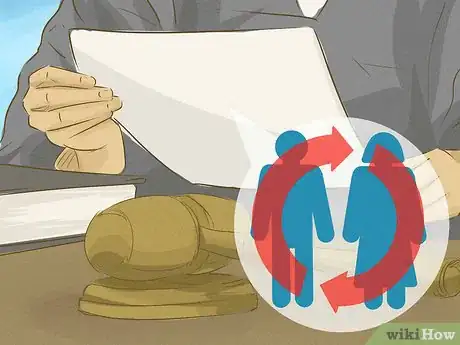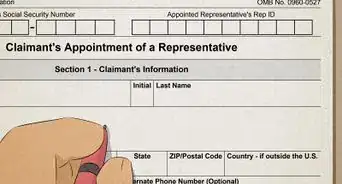This article was co-authored by Clinton M. Sandvick, JD, PhD. Clinton M. Sandvick worked as a civil litigator in California for over 7 years. He received his JD from the University of Wisconsin-Madison in 1998 and his PhD in American History from the University of Oregon in 2013.
There are 7 references cited in this article, which can be found at the bottom of the page.
wikiHow marks an article as reader-approved once it receives enough positive feedback. In this case, several readers have written to tell us that this article was helpful to them, earning it our reader-approved status.
This article has been viewed 123,890 times.
Guardianship, also known as conservatorship, is a legal process used when an adult is no longer able to make safe and reasonable decisions about health care or property. Guardianship is a serious decision that should not be taken lightly as it removes many of the legal rights this adult currently holds. There are alternatives to guardianship that should be considered first, if the situation allows for it.[1]
Steps
Knowing the Alternatives
-
1Determine what other legal documents exist. Going through the legal guardianship process is only required if the adult in question does not already have other legal documents completed. If they have both an “advance heath care directive” (i.e. living will) and a “durable power of attorney for finances,” guardianship may not be required. Guardianship should be considered as a last resort that is only requested if all other legal options have been exhausted.[2]
- If the adult in question is not yet at the point where they are incapable of making their own decisions, it is still possible to obtain these legal documents in order to prepare for a future when they may become incapacitated. Preparing these types of documents well in advance is the easiest and fastest way to ensure the adult receives the support their require when the time comes.
-
2Understand what a power of attorney is. A power of attorney (POA), in general, is a legal document that appoints one or more people (or institution) with the ability to make decisions regarding the adult's affairs. A POA for property or finances appoints someone to make decisions regarding the adult’s financial assets or property. A POA for health care appoints someone to make decisions regarding the adult’s medical treatment.[3]
- There are different kinds of POA, including:
- General POA — Provides specific people with the authority to manage all items (either financial or health care related, unless otherwise excluded) for a specified period of time. This type of POA ends if the adult in question becomes incapacitated, and does not imply that the adult is incapable of managing their own affairs.
- Specific POA — Provides specific people with the authority to manage specific items until a specified date, or until the specific items are finished. An example of a specific POA might be to give someone authority to sign real estate documents for the sale of a property because the owner isn’t able to do so in person.
- Durable POA — Is the same as a general POA, except that it allows the POA to continue if the adult becomes incapacitated. This type of POA has to specify that it is durable, otherwise it is considered general.
- Springing POA — Provides specific people with the authority to manage specific items at some future point in time. For example, this type of POA may indicate that it comes into effect if the adult becomes incapacitated, or if they are out of the country.
Advertisement - There are different kinds of POA, including:
-
3Read the details of a living will. A living will, or an advance health care directive, is a legal document that outlines how a person’s “end-of-life” decisions should be handled. It is written in advance of those decisions needing to be made, and it is written by the actual person it is for. It provides that person with a voice when they may not be able to speak for themselves (i.e. unconscious).[4]
- A living will would only come into effect if the adult is unable to make the decisions directly.
- A living will can be paired with a POA for health care, if required. Or it can outline some of the same responsibilities as a POA.
- A living will can name one or more people to oversee the adult’s health care and allow those people to make decisions that are not explicitly outlined in the living will.
- A living will often includes details on resuscitation and whether that adult wants any extreme measures to be taken should vital signs be lost.
-
4Review whether bank accounts are joint. A joint bank account is one that is “owned” by more than one person. A joint bank account can be an “either-or” situation or an “and” situation. An “either-or” situation is one where either of the account owners can do as they please with the account, they do not require the ‘permission’ of the other owner. An “and” situation is where both owners of the account must approve some or all transactions from the account.
- If a bank account (or other bank products) are joint, and either owner can use the bank account on their own, then a separate POA is not required for that joint owner to access the account. If one of the joint owners of a bank account passes away, the other owner becomes the sole owner of the account and its assets.
- If a bank account (or other bank products) are joint, but they require both owner’s approval to conduct transactions, a POA would be required to give permission to one owner to use the account without the approval of the other owner.
-
5See if revocable living trusts exist. A revocable living trust is essentially a will that can be used while the adult is still alive. It allows the estate to circumvent probate and allows the adult to have control over the assets for as long as they want. The primary trustee starts out as the original owner of the assets and is only transferred to one or more secondary trustees when certain criteria are met.[5]
- Trusts are very flexible and allow the owner a lot of control over where assets go and how they are used. For example, a trust can outline that a specific individual who inherits funds can only use those funds for specific purposes.
- Trusts are not public, unlike wills. Therefore whatever is written in a trust is confidential and will only be shared with certain individuals.
- Probate is a legal process all estates must go through, if no trust exists. Probate can be expensive and take a long time. In addition to the trust existing, all assets within the trust must be owned by trust (as opposed to specific individuals).
- Living trusts can be revoked or changed at any time by the primary trustee or owner — just like a will.
-
6Find out if a representative or substitute payee already exists. A representative or substitute payee is only required if the adult in question receives funds from the Social Security Administration (SSA) of the United States. This payee is responsible to handle the payments from SS to the incapacitated individual. The payee is also responsible to handle the disbursement of these payments on behalf of the incapacitated individual.[6]
- If a representative payee already exists, that person is responsible to ensure the SS payments go to pay for the individual’s needs.
- If a representative payee does not exist, you can apply to the SSA to become a payee. The SSA will conduct an investigation and will interview you before making a final decision.
Figuring Out If It’s Time
-
1Realize that you are removing their constitutional rights. When you arrange for guardianship of an adult, that adult loses a number of the rights they enjoyed as an adult. Consider whether this is the best option for them at the moment. Are there alternatives that could work, even temporarily? Would the removal of any of these rights cause them undue hardship? Or would the removal of any of these rights protect them and the people around them? Examples of the types of rights this adult would lose are as follows:[7]
- The right to decide where and how they want to live.
- The right to determine what medical treatment they will and will not receive.
- The right to decide whether they want any extraordinary measures to be taken if they’re dying.
- The ability to have a driver’s license.
- The ability to own, buy, sell and manage property of any kind.
- The ability to own or possess a firearm or other type of weapon.
- The ability to enter into contracts or file lawsuits against others.
- The ability to marry someone.
- The ability to vote in any type of election.
-
2Talk to them to find out what they want. Guardianship decisions are difficult and should not be made by you alone. When deciding if it’s time to obtain guardianship of a specific adult, ensure you take that adult's wishes into account. Hopefully you’ve had a chance to talk on the subject with this adult in the past, or can talk to them now. If not, think about what they believe in and value and make sure your decision aligns with those.[8]
- If the person is capable of it, review guardianship and its alternatives together and let them take the lead.
- If they don't fully understand, do your best to give a summary in plain language, so they know what's going on and can make as many choices as they are able to.
- This is a good time to think about the plans you need to make for your future, and the future of your other family members. When you have time, take the opportunity to sit and talk with them. Document your wishes, and those of your family members for future reference.
-
3Understand which state has authority. The state in which the adult (for whom guardianship is being sought) lives is the state who has authority over granting guardianship requests. And each state has slightly different procedures for granting guardianship that you must understand. Most, if not all, states have detailed procedural information on their websites to help you understand the process.[9]
- Note that the extent to which guardianship is granted is defined by the court. They will usually only grant enough authority to the guardian as is required to keep the adult safe — nothing more. The guardian must operate within the parameters set out by the court.
- Guardianship can be granted to a family member, friend, or private or public entity, as seen fit by the court.
-
4Determine the type of guardianship required. Guardianship can be granted for a person or for an estate. You need to determine which type of guardianship may be required for the adult in question. Having guardianship of the person means you can make all decisions regarding their person (e.g. movement, education, medical, etc.). Having guardianship of an estate means you have the ability to oversee all the decisions regarding the property included in the estate (e.g. real estate, bank accounts, debt responsibilities, etc.).[10]
- Guardianship for a person may include having the following responsibilities:
- Being able to determine where the adult should live, and how they live.
- Being able to determine what medical treatment the adult receives.
- Being able to decide what education and/or counselling the adult receives.
- Consent to the release of confidential information about the adult.
- Being able to make end-of-life decisions on behalf of the adult.
- Acting as a representative payee for the adult.
- Ensuring the adult can maintain the maximum amount of independence possible.
- Reporting to the court regarding the adult on a regular basis.
- Guardianship for an estate may include having the following responsibilities:
- Being able to marshall and protect assets owned by the adult.
- Being able to get property appraised.
- Being able to make decisions that helps to protect property and assets from loss.
- Being able to receive income from estate assets on behalf of the adult.
- Being able to make whatever payouts and disbursements required by the estate.
- Most likely you will be required to obtain court approval before selling any assets belonging to the adult.
- Reporting to the court regarding the estate on a regular basis.
- Guardianship for a person may include having the following responsibilities:
-
5Decide who the guardian will be. A guardian can be a family member, a friend, or another entity. The other ‘entity’ can include a professional guardian. Professional guardians are people who provide guardianship services as their job. They take specific training courses about guardianship and become certified as professional guardians.[11]
- Professional guardians may be useful to family members who do not reside near the person who needs a guardian.
- Professional guardians will help to select and monitor any types of services required by the adult, such as selecting a nursing home or in-home care, approving medical treatment, etc.
- Some professional guardians obtain access to the financial assets of the person for whom they are a guardian, in order to pay for the services the adult requires. However, those assets never become the property of the guardian, and the guardian must provide financial reports to the court on a regular basis for each person for whom they are a guardian.
- Guardians, of any type, must be at least 18 years of age or older.
- Unfortunately, sometimes family members disagree as to who should be appointed guardian. If there is more than one opinion as to who should be appointed, family members will need to present their option in court and provide evidence why that option is the best one. The final decision will be left up to the judge.[12]
-
6Be prepared to periodically check up with the adult. You or someone else should be able to talk with them every once and a while to see if they feel that guardianship is suiting them well, and if they are having any problems. It's possible that the adult will gain more skills, and be ready for more independence than they could handle before.
- Do they have any problems or frustrations? How could you fix or work around these issues?
- What is working well?
- What could be improved?
- How has their situation changed lately? Are their needs and skills different?
- It's important to help the adult feel that they have a say in the direction of their lives, even if they aren't capable of independence. Take time to listen to them and make them feel heard.
Understanding the Legal Process
-
1Determine if emergency guardianship is required. Guardianship can be granted by the court in emergency situations without going through the full legal proceedings. Emergency situations are normally restricted to a specific period of time and purpose, and must be followed up with a full guardianship proceeding if guardianship is to continue.
- This process, while faster than the full proceedings, may still take several days.
-
2Conduct a preliminary investigation. Most states require that an investigation is conducted to determine if there is truly a need for guardianship. While the details about this investigation differ by state, in general the results should include:
- An overview of the disability the adult has, and how that disability is affecting decision making capabilities.
- An overview of the adult’s mental and health status, education, adaptive behaviour and social skills.
- An opinion (by the investigator) regarding the need for guardianship, including supporting evidence of this opinion.
- Recommendations for adult in question, including residence and treatment.
-
3File a petition for guardianship. A petition for guardianship needs to be filed within the court system in order to start the legal proceedings for the appointment of a guardian. The petition is filed by whomever is requesting guardianship (i.e. a family member or friend, doctor, etc.), not by the adult in need of a guardian.
- Not all states require that this process be completed by a lawyer. However, it is certainly beneficial to — at the very least — consult a lawyer for advice before proceeding with the guardianship process.
- Once a petition is filed, it can take up to 2 months before a guardian is legally appointed.
- Some states do not charge a fee to file a guardianship petition, but check with the specific court where you file to confirm if there are any costs involved.
-
4Submit a medical certificate or a clinical team report. In some states, a medical certificate must be provided to the court at the time of the petition. This certificate is completed by a doctor, or other specific health care provider, and includes details of the medical examination of the person for which guardianship is being sought. In most cases the certificate will be a result of the preliminary investigation that was conducted earlier in the process. A clinical team report may be required in some states for someone who is being declared as "intellectually disabled."
- The medical certificate cannot be dated more than 30 days before the date of the petition.
- The clinical team report cannot be dated more than 180 days before the date of the petition.
- The clinical team report must be completed by multiple people, normally a doctor, a licensed psychologist and a social worker.
-
5Complete a Statement of Acts or Bond. If you are the person requesting to be the guardian (or nominated to be the guardian) you will most likely need to file specific documents with the court before the hearing. Each state has slightly different requirements as to what forms are required. Some examples are noted here:
- In the State of Wisconsin, each proposed guardian is required to file a Statement of Acts to the court at least 96 hours before the hearing. This statement includes information on the proposed guardian’s criminal and financial past, as well as any record of abuse, neglect or exploitation.[13]
- In the State of Massachusetts, each proposed guardian must file a Bond. The Bond will include the estimated value of the adult’s real estate and other financial assets. For the purpose of this Bond, the proposed guardian will be allowed to gather information about these assets, but they will not have any control over them until they are officially appointed.
-
6Appoint a guardian ad litem. Once a petition is filed requesting guardianship for a specific adult, the court will appoint that adult legal representation (also known as guardian ad litem). This lawyer will be someone who has not been involved with the adult previously and has no personal interest in the case. Their job is to objectively represent the legal rights of the adult for whom guardianship is being sought. The guardian ad litem has the following responsibilities:[14]
- They must meet with the adult in person and explain what the guardianship petition means. They will also explain to the adult what rights they have in the court proceedings.
- They will determine what the adult’s opinion is regarding the guardianship request. While the guardian ad litem will take the adult’s opinions into account, in the end they’ll act in the best interests of the adult.
- They will interview the proposed guardian(s) to evaluate fitness and suitability.
- They will review any advanced planning that is already taken place for the adult, including POAs and other legal documents.
- If necessary, they can request additional evaluations of the adult be conducted before the hearing.
- They will provide the court with their opinion and recommendation as to the specific case, based on their research and investigation. These opinions and recommendations will be based on what is best for the adult in question, and what options will be least restrictive to this adult.
- Note that the adult has the right to hire they own attorney for guardianship proceedings. The guardian ad litem is basing their opinion on what is best for the adult, not necessarily on what the adult may want.
-
7Receive a summons to appear in court. Once a petition is filed with the court system, a hearing date will be determined and communicated to all those involved. This communication will include a summons to the adult for whom guardianship is being requested. This is the “official” notice to that adult that someone is requesting they receive guardianship.
- While this summons is the “official” notice form the courts to the adult in question, it is hopefully not the first time they’re hearing about such a proceeding. However, if the petition was filed by doctors or a service provider (i.e. nursing home), it may be the first time this person becomes aware of such a request.
- Information pertaining to the hearing (i.e. date, time and place) is also provided to all interested parties (i.e. family members, proposed guardian, doctors, etc.) so they can attend the hearing if required.
-
8Attend the court hearing. The hearing for guardianship is conducted like any other type of court proceedings. Evidence is presented by both “sides” (i.e. the person requesting guardianship and the adult for whom guardianship is being requested). The adult in question is normally represented by a lawyer, who will act objectively on their behalf.
- In most states, the hearing will occur within 90 days of the petition being filed.
- The adult for whom guardianship is being requested has several rights in these proceedings, which include:
- The right to be notified of, and to attend, all proceedings in person.
- The right to obtain individual counsel to represent them.
- The right to cross-examine witnesses at the hearing, and present their own evidence.
- The right to request the hearing be conducted in front of a jury, instead of only a judge.
- Many of these rights are obviously more important in cases where the adult is contesting the need for guardianship. If all sides have agreed that guardianship is required, the hearing may simply be part of the formal process to make it official.
-
9File a guardianship care plan annually. Once a guardian has been appointed by the court, they will most likely be required to submit a care plan within a certain period of time (such as 60 days). This report will include items such as: contact information; the adult’s current needs; the adult’s anticipated future needs; the adult’s financial situation; frequency of visitation; etc.
- Normally the care plan is reviewed by the court and either approved or not approved. After the initial report, an annual report will be required to update the court on the adult’s situation.
References
- ↑ https://www.guardianship.org/what-is-guardianship/
- ↑ https://www.caring.com/articles/adult-guardianship
- ↑ https://www.caring.com/articles/what-is-power-of-attorney-for-finances
- ↑ https://www.caring.com/articles/living-wills
- ↑ https://www.caring.com/articles/revocable-living-trust
- ↑ http://elderlaw.uslegal.com/representative-payee-ssa/
- ↑ https://www.guardianship.org/what-is-guardianship/
- ↑ https://www.guardianship.org/what-is-guardianship/
- ↑ https://www.guardianship.org/what-is-guardianship/
About This Article
The right way to arrange for guardianship of an impaired adult will depend on the state you live in, but generally, the first step is filing a petition for guardianship with the court system. Once you file a petition, there will usually be an investigation conducted to determine whether or not guardianship is necessary. Additionally, you may need to submit a medical certificate that's been filled out by a doctor who has examined the person you're seeking guardianship for. After you've submitted the petition and the investigation has been completed, you'll need to attend a court hearing, where a judge will decide whether to appoint a guardian. Keep in mind that the entire process can take several months, but it can be expedited if there are emergency circumstances. For advice from our Legal co-author, like how to determine if guardianship is necessary, keep reading.
















































































